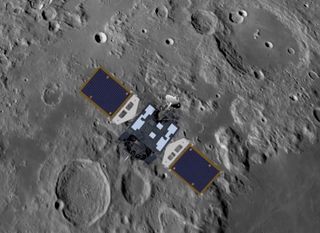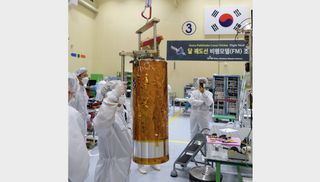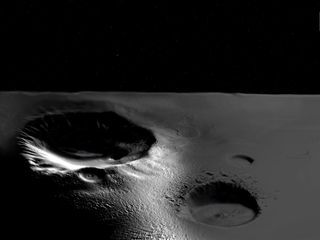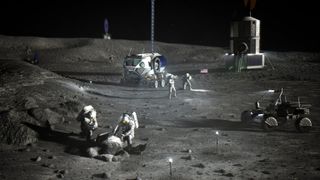
South Korea is ready to launch its 1st moon mission
The Korea Pathfinder Lunar Orbiter will lift off on Aug. 2.

The launch of South Korea's first moon mission is just a week away.
The Korea Pathfinder Lunar Orbiter, or KPLO for short, is scheduled to launch atop a SpaceX Falcon 9 rocket next Tuesday (Aug. 2). The mission is viewed as the first step in South Korea's ambitious deep-space agenda, which also includes a robotic landing onto the moon by 2030 and an asteroid sample-return mission.
In May of this year, KPLO was officially named "Danuri," a blend of two Korean words that mean "moon" and "enjoy."
The test lunar orbiter will carry a total of six payloads. Five were developed by Korean universities and research organizations, including the Korean Aerospace Research Institute (KARI), and the other is from NASA.
The six experiments are the Lunar Terrain Imager (LUTI), the Wide-Angle Polarimetric Camera (PolCam), a magnetometer called KMAG, a gamma-ray spectrometer known as KGRS, the Disruption Tolerant Network Experiment Payload (DTNPL) and a high-sensitivity camera funded by NASA called ShadowCam.
Related: Every mission to the moon (reference)

Key tasks
Danuri will circle the moon for at least a year, if all goes according to plan. The orbiter's key tasks will be to measure the magnetic force above the surface of the moon and assess lunar resources such as water ice, uranium, helium-3, silicon and aluminum, as well as to crank out a topographic map to help pick out future lunar landing spots.
Get the Space.com Newsletter
Breaking space news, the latest updates on rocket launches, skywatching events and more!
It will take the probe a while to get to the moon after its Falcon 9 launch; Danuri will use a ballistic lunar transfer pathway, eventually arriving in lunar orbit in mid-December.
KARI, which is headquartered in Daejeon, provided NASA with about 33 pounds (15 kilograms) of payload mass on the orbiter.
In September 2016, NASA issued a solicitation seeking science instruments designed to enhance knowledge of the distribution of volatiles such as water, including the movement of such resources toward lunar permanently shadowed regions (PSRs) and how they become trapped there.
The result was NASA's selection of ShadowCam, an instrument developed by Arizona State University and San Diego-based Malin Space Science Systems. ShadowCam will acquire images of shadowed regions of the moon using a high-resolution camera, telescope and highly sensitive sensors.
The instrument's optical camera is based on the Narrow Angle Camera (NAC) aboard NASA's Lunar Reconnaissance Orbiter (LRO). NAC has been churning out images of the moon for over 13 years now — but the new camera for KPLO is far more sensitive.
Related: Water on the moon is more common than we thought, studies reveal

The shadow knows
ShadowCam will collect high-resolution images of PSRs while flying at about 62 miles (100 kilometers) above the moon's surface for about a year, said Prasun Mahanti, deputy principal investigator for ShadowCam at Arizona State University in Tempe.
"PSRs typically exist at lower reaches of host craters and topographic depressions where sunlight never reaches, making these regions extremely cold and hence favorable locations where volatile species, e.g., water, methane and ammonia, can remain trapped (cold traps) for long geologic time periods," Mahanti told Space.com.
ShadowCam will help search for water ice in polar craters by mapping reflectance within PSRs, Mahanti said. PSRs are illuminated only indirectly, by light reflected from nearby topographic features.
This "secondary illumination" is very dim, Mahanti said. But ShadowCam is optimized for imaging under deficient lighting conditions, being over 200 times more sensitive than LRO's NAC (which is one of two cameras that make up the older orbiter's Lunar Reconnaissance Orbiter Camera system, or LROC).
"Just like LROC NAC, which has changed our understanding of the moon by collecting unprecedented amounts of high-resolution lunar images, ShadowCam will peer into the moon's deeply shadowed areas to provide the first ever high-resolution look into lunar permanently shadowed regions," Mahanti said.

Challenging regions
"It's a new data set we don't have," said Ben Bussey, a ShadowCam co-investigator at the Johns Hopkins University Applied Physics Laboratory in Laurel, Maryland.
"The plan is to map both poles throughout the year," he said. "Doing so, we can also look for possible seasonal variations in some of these signatures, if any of the volatiles are transient in any way."
Bussey told Space.com that ShadowCam will not only look for evidence of water. Another purpose is identifying hazards and determining trafficability inside PSRs, potentially helping mission planners plot treks into and out of these features by future rovers.
"The more precursor data we can have of these challenging regions, the more efficient we will be with our exploration," Bussey said. "Permanently shadowed regions are never going to be easy."
The ShadowCam science team has enjoyed working with their Korean colleagues, Bussey said. The Danuri team has a very impressive payload suite on the nation's first moon orbiter, he said.
As always, the moon looms. And as more nations tease out more detail about Earth's nearest neighbor, the more viable it becomes as a target of sustained human exploration.
Leonard David is author of the book "Moon Rush: The New Space Race," published by National Geographic in May 2019. A longtime writer for Space.com, David has been reporting on the space industry for more than five decades. Follow us on Twitter @Spacedotcom or on Facebook.
Join our Space Forums to keep talking space on the latest missions, night sky and more! And if you have a news tip, correction or comment, let us know at: community@space.com.

Leonard David is an award-winning space journalist who has been reporting on space activities for more than 50 years. Currently writing as Space.com's Space Insider Columnist among his other projects, Leonard has authored numerous books on space exploration, Mars missions and more, with his latest being "Moon Rush: The New Space Race" published in 2019 by National Geographic. He also wrote "Mars: Our Future on the Red Planet" released in 2016 by National Geographic. Leonard has served as a correspondent for SpaceNews, Scientific American and Aerospace America for the AIAA. He was received many awards, including the first Ordway Award for Sustained Excellence in Spaceflight History in 2015 at the AAS Wernher von Braun Memorial Symposium. You can find out Leonard's latest project at his website and on Twitter.
